
Keep the lights on. Make the grid smarter.
Opinions expressed whether in general or in both on the performance of individual investments and in a wider economic context represent the views of the contributor at the time of preparation.
Executive summary: Electricity grids need an overhaul. Not only are global energy needs constantly expanding, but current grids were built for a different era. In the future, grids will have to get smarter if we want the lights to stay on. As with almost every other industry, increased digital deployment has the potential to be highly transformational. Smart grids will monitor in real time where power is coming from and where it will be needed. They can bring marked increases in reliability, flexibility, efficiency, and sustainability. Over 15 countries globally currently have smart grid projects underway. Add in the deployment of microgrids and this figure grows substantially. Look further ahead and the global market could expand at least fourfold from its current size, reaching ~$150bn by 2030. Smart grid deployment will not always be easy, however, given its complexity. Buy-in from governments, regulators and utilities also matters. Clear investment opportunities will still arise. At present, there are few dedicated pure-plays and those that tend to be relatively small in size. Larger systems integrators will clearly benefit. Look further ahead, and as the industry gets smarter, so should potential investors.
Few people even think about the power grid until their lights go out. When they do, that’s when the constraints of the current energy transmission system become alarmingly apparent. Today’s grids are antiquated and in need of a major overhaul to reflect the new reality of energy management. Gone is the model of centralised grids built to take power from large stations and carry it to the millions of homes and businesses where it is used. In its place will be a grid system that is inherently smarter, which works bidirectionally (users can also be suppliers) and is much better equipped for the 21st century.
Most electricity transmission systems in the developed world were built in the 1950s and 1960s. Given that they were typically designed with a 50-year life expectancy, it is not surprising that they have now “reached or surpassed their intended lifespan”, per a report issued by the American Society of Civil Engineers in September 2020. Ageing transmission lines are subject to failure not simply through use but also owing to extreme weather conditions (hurricanes, floods, heatwaves and so on), which can often overwhelm the infrastructure. Unmodernised grids may also be subject to cyberattacks and malware, as the Colonial Pipeline incident of May 2021 showed. Russia’s invasion of Ukraine has only increased concerns in this respect. Also, don’t forget that power outages are not just an emerging market issue. While 350m people were affected globally last year, the number of reported annual incidents in the US has grown from fewer than 25 in 2000 to over 180 (per IHS Markit).
At the same time that the supply of energy is under pressure, demand is only heading in one direction. Global energy demand is set to grow by 60% over the period 2020-2050, driven not just by population growth, increased industrialisation and expanding incomes, but also by electric vehicles, an increasing proliferation of smart devices and the growing deployment of IoT (internet of things) networks. Bloomberg New Energy Foundation – the source for the above data – estimates that over $28tr would theoretically need to be spent worldwide to provide all the support required to meet such a level of demand.
Where best to spend this money? Although the epithet ‘smart’ is applied to many transformative technologies, the future for electricity grids lies in making them inherently smarter. What this means in practical terms is deploying solutions to monitor in real time where power is coming from and where it is needed. Think of a smart grid as containing intelligent devices at all points in the electricity network (from high-voltage transmission lines to appliances in the home) that can send information and receive instructions.
In most electric grids today, power flows in one direction. However, smart-grid technologies help make the network two-way with the ability for power and communication to flow in both directions. Complex, two-way communication is essential to capture power generated by customers with their own solar panels or wind generators. Those customers receive power from the grid when their supplies are low, but also send power into the grid when their supplies generate excess electricity.
A smart grid can then be characterised by four key features: its reliability, flexibility (the ability to handle bidirectional energy flows), efficiency (better load adjustment and balancing) and sustainability (integrating renewable energy sources). Smart grid systems would almost certainly include microgrids within them. Think of a microgrid as being a decentralised source of electricity that can disconnect from the main grid infrastructure and function autonomously as technical or economic conditions dictate (in the event of extreme weather conditions, for example). In this way, microgrids could improve security of supply and can provide emergency power. These are ideal both for more remote communities and for emerging economies who may typically bypass conventional grid infrastructure.
This is just the beginning. Digital technologies, more broadly, could help transform grid operations. Predictive maintenance, based on machine learning and artificial intelligence can help reduce power outages and improve companies’ investment and maintenance decisions. Drones could carry out field inspections, replacing workers, while sensors would permit for more real time monitoring. Robotic processes and automation would markedly improve back-office functions. Maintenance expenditures could be reduced by 20% and distribution losses by 15% over a ten-year horizon through digital implementation, per work from the Boston Consulting Group.
At least 15 countries around the world have begun to deploy smart grid solutions. The earliest (and still one of the largest) examples of a smart grid is the Italian system installed by ENEL. Completed in 2005, the Telegestore project was highly unusual in the utility world because the company designed and manufactured its own meters, acted as its own systems integrator and developed its own system software. It remains a success, delivering annual cost savings of ~€500m (versus an original build cost of ~€2.1bn). Currently over 500 discrete smart grid projects are underway across Europe, per data from the European Union. These initiatives include the integration of parts of various national grid systems (for example, between Hungary and Slovakia, or Germany and the Czech Republic) to improve distribution and service quality. Other developments are to ensure improved provision and monitoring in more remote areas. Meanwhile, businesses in some geographies (particularly the Netherlands) are upgrading parts of their grid to integrate electric vehicle solutions.
Although deployment is most advanced in Europe, there are reasons for optimism in other regions, particularly the US. While over 100m American homes are currently equipped with smart meters (per the US Pacific Gas & Electricity Company), the US Infrastructure Bill has the potential to kickstart America’s grid overhaul. The Bill allocates potentially up to $65bn for the nation’s electrical system for it to deliver 100% clean energy to businesses and homeowners by 2035. This budget includes the buildout of transmission lines and funding for smart grid research and development. Similar projects (with varying degrees of maturity) are also underway in countries including Australia, China and South Korea. Additionally, there are currently over 4,500 microgrid deployments underway around the world (per Guidehouse Insights).
All the technology required to make the electricity grid smart(er) already exists. The challenge is to find ways to make its deployment commercially viable and politically acceptable. The speed of disruption and the regulatory embrace of new solutions will vary market by market. Owing to the complexity and often fundamental change required for operating models, the smart grid opportunity is also a challenge. Many energy utilities are constrained by the often bureaucratic and hierarchical nature of their organisation (anecdotally, a majority have yet to recruit Chief Technology Officers), while regulators typically tend to be risk averse in their planning. In all cases, access to funding is critical. It makes sense to run pilot programmes to test new technologies, but above all, it is crucial to ensure that a new version of the old grid is not built by adding piecemeal solutions rather than a more considered overhaul.
The global smart grid market is currently worth $30-40bn (depending on how different consultancies define the market’s size and scope) but should grow at a 15-20% CAGR through until the end of this decade, implying a market worth around $150-160bn by this time. While North America will be the largest market for smart grid deployment, Asia will likely be the region to experience the fastest growth. In addition, do not forget the seventh sustainable Development Goal of the United Nations: universal access to energy by 2030. For this to be achieved, there would need to be a 35% increase in power connections globally between 2015 and the end of this decade. Even if this target is not met, expect an increasing deployment of microgrids globally.
Against this background, there is a significant investment opportunity ahead. The challenge, however, is to identify how best to benefit from it. There are many different angles. Remember also that regulators will have an influence, not just in defining the parameters of permitted returns for utility businesses, but also in potentially taking a view on whether more independent businesses (as opposed to grid operators) should act as platform providers. Furthermore, deploying smarter grids is a complex issue, in which alternative energy businesses, hardware, software and installation companies will all play a role.
While large and diversified companies including ABB, GE,Hitachi, IBM, Schneider Electric and Siemens will all likely continue to play a role in offering key solutions to support smart grid proliferation, finding more dedicated pure-play businesses is more of a challenge. Businesses which could benefit include Alfen (a provider of integrated smart energy solutions including grids, storage and electric vehicle charging points), EVgo (another provider of charging solutions) and Landis&GyrGroup (a leader in smart grid software). However, all three of these businesses are currently small, with ~$2bn market capitalisations. Adjacent, or indirect opportunities might include businesses such as Quanta Services and MasTec (specialist grid infrastructure contractors), Itron (a leading data analytics provider for the utility industry) or Xylem (a leader in water industry technology solutions). Broader ETF options also exist, but given the runway for smart grid solutions ahead, investors interested within the space may also need to get smarter.
Alex Gunz, Fund Manager, Heptagon Capital
Disclaimers
The document is provided for information purposes only and does not constitute investment advice or any recommendation to buy, or sell or otherwise transact in any investments. The document is not intended to be construed as investment research. The contents of this document are based upon sources of information which Heptagon Capital LLP believes to be reliable. However, except to the extent required by applicable law or regulations, no guarantee, warranty or representation (express or implied) is given as to the accuracy or completeness of this document or its contents and, Heptagon Capital LLP, its affiliate companies and its members, officers, employees, agents and advisors do not accept any liability or responsibility in respect of the information or any views expressed herein. Opinions expressed whether in general or in both on the performance of individual investments and in a wider economic context represent the views of the contributor at the time of preparation. Where this document provides forward-looking statements which are based on relevant reports, current opinions, expectations and projections, actual results could differ materially from those anticipated in such statements. All opinions and estimates included in the document are subject to change without notice and Heptagon Capital LLP is under no obligation to update or revise information contained in the document. Furthermore, Heptagon Capital LLP disclaims any liability for any loss, damage, costs or expenses (including direct, indirect, special and consequential) howsoever arising which any person may suffer or incur as a result of viewing or utilising any information included in this document.
The document is protected by copyright. The use of any trademarks and logos displayed in the document without Heptagon Capital LLP’s prior written consent is strictly prohibited. Information in the document must not be published or redistributed without Heptagon Capital LLP’s prior written consent.
Heptagon Capital LLP, 63 Brook Street, Mayfair, London W1K 4HS
tel +44 20 7070 1800
email [email protected]
Partnership No: OC307355 Registered in England and Wales Authorised & Regulated by the Financial Conduct Authority
Heptagon Capital Limited is licenced to conduct investment services by the Malta Financial Services Authority.



